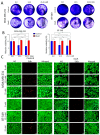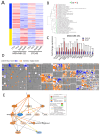Disrupted Lipid Metabolism, Cytokine Signaling, and Dormancy: Hallmarks of Doxorubicin-Resistant Triple-Negative Breast Cancer Models
- PMID: 39766172
- PMCID: PMC11674486
- DOI: 10.3390/cancers16244273
Disrupted Lipid Metabolism, Cytokine Signaling, and Dormancy: Hallmarks of Doxorubicin-Resistant Triple-Negative Breast Cancer Models
Abstract
Background: Chemoresistance in triple-negative breast cancer (TNBC) presents a significant clinical hurdle, limiting the efficacy of treatments like doxorubicin. This study aimed to explore the molecular changes associated with doxorubicin resistance and identify potential therapeutic targets to overcome this resistance, thereby improving treatment outcomes for TNBC patients.
Methods: Doxorubicin-resistant (DoxR) TNBC models (MDA-MB-231 and BT-549) were generated by exposing cells to increasing concentrations of doxorubicin. RNA sequencing (RNA-Seq) was performed using the Illumina platform, followed by bioinformatics analysis with CLC Genomics Workbench and iDEP. Functional assays assessed proliferation, sphere formation, migration, and cell cycle changes. Protein expression and phosphorylation were confirmed via Western blotting. Pathway and network analyses were conducted using Ingenuity Pathway Analysis (IPA) and STRING, while survival analysis was performed using Kaplan-Meier Plotter database.
Results: DoxR cells exhibited reduced proliferation, sphere formation, and migration, but showed enhanced tolerance to doxorubicin. Increased CHK2 and p53 phosphorylation indicated cellular dormancy as a resistance mechanism. RNA-Seq analysis revealed upregulation of cytokine signaling and stress-response pathways, while cholesterol and lipid biosynthesis were suppressed. Activation of the IL1β cytokine network was prominent in DoxR cells, and CRISPR-Cas9 screens data identified dependencies on genes involved in rRNA biogenesis and metabolism. A 27-gene signature associated with doxorubicin resistance was linked to worse clinical outcomes in a large breast cancer cohort (HR = 1.76, FDR p < 2.0 × 10-13).
Conclusions: This study uncovers potential therapeutic strategies for overcoming TNBC resistance, including dormancy reversal and targeting onco-ribosomal pathways and cytokine signaling networks, to improve the efficacy of doxorubicin-based treatments.
Keywords: cellular dormancy; chemoresistance; doxorubicin; therapeutic strategies; triple-negative breast cancer (TNBC).
Conflict of interest statement
The authors declare no conflicts of interest.
Figures





Similar articles
-
Interference KRT17 reverses doxorubicin resistance in triple-negative breast cancer cells by Wnt/β-catenin signaling pathway.Genes Genomics. 2023 Oct;45(10):1329-1338. doi: 10.1007/s13258-023-01437-y. Epub 2023 Aug 27. Genes Genomics. 2023. PMID: 37634232 Free PMC article.
-
Excellent effects and possible mechanisms of action of a new antibody-drug conjugate against EGFR-positive triple-negative breast cancer.Mil Med Res. 2021 Dec 9;8(1):63. doi: 10.1186/s40779-021-00358-9. Mil Med Res. 2021. PMID: 34879870 Free PMC article.
-
CircRNA-CREIT inhibits stress granule assembly and overcomes doxorubicin resistance in TNBC by destabilizing PKR.J Hematol Oncol. 2022 Aug 29;15(1):122. doi: 10.1186/s13045-022-01345-w. J Hematol Oncol. 2022. PMID: 36038948 Free PMC article.
-
Identification of DDIT4 as a potential prognostic marker associated with chemotherapeutic and immunotherapeutic response in triple-negative breast cancer.World J Surg Oncol. 2023 Jun 30;21(1):194. doi: 10.1186/s12957-023-03078-7. World J Surg Oncol. 2023. PMID: 37391802 Free PMC article.
-
Down-regulating GRP78 reverses pirarubicin resistance of triple negative breast cancer by miR-495-3p mimics and involves the p-AKT/mTOR pathway.Biosci Rep. 2022 Jan 28;42(1):BSR20210245. doi: 10.1042/BSR20210245. Biosci Rep. 2022. PMID: 34935899 Free PMC article.
Cited by
-
Bridging the Gap in Breast Cancer Dormancy: Models, Mechanisms, and Translational Challenges.Pharmaceuticals (Basel). 2025 Jun 26;18(7):961. doi: 10.3390/ph18070961. Pharmaceuticals (Basel). 2025. PMID: 40732251 Free PMC article. Review.
-
Epigenetic Silencing of miR-218-5p Modulates BIRC5 and DDX21 Expression to Promote Colorectal Cancer Progression.Int J Mol Sci. 2025 Apr 27;26(9):4146. doi: 10.3390/ijms26094146. Int J Mol Sci. 2025. PMID: 40362385 Free PMC article.
-
Circular RNA profiling identifies circ_0001522, circ_0001278, and circ_0001801 as predictors of unfavorable prognosis and drivers of triple-negative breast cancer hallmarks.Cell Death Discov. 2025 Jul 9;11(1):316. doi: 10.1038/s41420-025-02576-9. Cell Death Discov. 2025. PMID: 40634303 Free PMC article.
References
-
- Garrido-Castro A.C., Lin N.U., Polyak K. Insights into Molecular Classifications of Triple-Negative Breast Cancer: Improving Patient Selection for Treatment. Cancer Discov. 2019;9:176–198. doi: 10.1158/2159-8290.CD-18-1177. - DOI - PMC - PubMed
-
- Santonja A., Sanchez-Munoz A., Lluch A., Chica-Parrado M.R., Albanell J., Chacon J.I., Antolin S., Jerez J.M., de la Haba J., de Luque V., et al. Triple negative breast cancer subtypes and pathologic complete response rate to neoadjuvant chemotherapy. Oncotarget. 2018;9:26406–26416. doi: 10.18632/oncotarget.25413. - DOI - PMC - PubMed
Grants and funding
LinkOut - more resources
Full Text Sources
Research Materials
Miscellaneous

